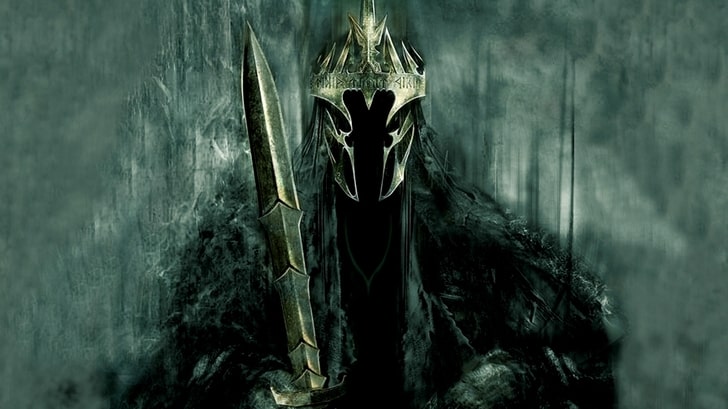
The Nazgûl are some of the most memorable monsters seen in The Lord of the Rings. This makes perfect sense because they were the chief enforcers of Sauron in the Third Age, meaning that they merited increased consideration. In any case, the fame of The Lord of the Rings means that the Nazgûl have had a huge impact on fantasy fiction, so much so that the signs of their influence are ubiquitous. Here are 10 things that you may or may not have known about the Nazgûl:
1. The Name Means “Ringwraith”
J.R.R. Tolkien was a linguist with a special fondness for coming up with his own languages. Naturally, this means that Nazgûl is a term with meaning. For those who are curious, Nazgûl is Black Speech for “ringwraith,” which is a very literal label for these entities. As for the Black Speech, suffice to say that it was the language that Sauron created for use by his servants, with the result that it is more incomplete compared to Tolkien’s other invented languages because it saw so little use in the books.
2. Nine Nazgûl For Nine Rings
There are nine Nazgûl because Sauron created nine rings for Men. Each of the nine rings was handed out to a mortal ruler, who proceeded to use its incredible powers to secure enormous power and prestige. Unfortunately for said individuals, the nine rings were poisoned gifts that caused their mortal forms to fade from existence bit by bit in a process that culminated in them becoming wraiths bound to Sauron’s One Ring.
3. Most Are Unnamed
Most of the Nazgûl were never named. In fact, out of the nine, one is mentioned to be the Witch-King of Angmar in The Lord of the Rings. Besides him, a second Nazgûl was named Khamûl in the legendarium, which refers to the full collection of Tolkien’s writings that form the background for his most famous creation.
4. Most Have Unclear Backgrounds
On a related note, Tolkien mentioned little about the backgrounds of the Nazgûl. He stated that three of the Nazgûl were once Númenóreans, with the Witch-King of Angmar being one potential candidate. Furthermore, he stated that Khamûl was an Easterling, as shown by titles such as the “Black Easterling” and the “Shadow of the East.” Otherwise, nothing was said about the backgrounds of the other Nazgûl, perhaps because their corruption meant that said information wasn’t particularly important.
5. Most Potent Weapon Was Fear
The Nazgûl possessed a number of ways to inflict suffering upon others. For example, since Sauron was once one of the Maiar of Aulë, it should come as no surprise to learn that the Nazgûl had magical weapons. Likewise, the Nazgûl had breath of sorts in spite of their condition, which was poisonous enough to kill with sufficient exposure. However, the most potent weapon of the Nazgûl was the fear that they inspired in living creatures, which was shown to considerable effect in the Siege of Minas Tirith.
6. Had Issues Interacting with the Material World
Wraiths being wraiths, the Nazgûl had serious issues interacting with the material world. To be exact, they couldn’t interact with the material world at all without the arms and armor provided to them by their master, which provided them with some semblance of physical form. Due to this, it was possible to fend off the Nazgûl by destroying that arms and armor, thus forcing them to leave in order to receive replacements. However, this same condition meant that normal weapons couldn’t hurt them, thus posing a serious problem for their enemies.
7. Their Mounts Resembled Pterosaurs
It is unclear what the flying mounts of the Nazgûl were supposed to be. Certainly, the creatures weren’t birds, seeing as how their wings consisted of “webs of hide between horned fingers.” However, it is interesting to note that some people have seen a resemblance between them and pterosaurs, which was confirmed to some extent by Tolkien, who stated that they weren’t meant to be pterosaurs but nonetheless bore a resemblance to them. Moreover, he stated that it was possible that the creatures were survivors from earlier geological periods, thus strengthening that particular idea.
8. The Witch-King Brought About the Destruction of Arnor
Gondor had a sister-realm to the north called Arnor, which had split into three kingdoms called Cardolan, Rhudaur, and Arthedain. Due to this, the Witch-King believed Arnor to be more vulnerable than Gondor, which was why he inflamed their enmities before striking when he was ready. The Witch-King managed to destroy both Rhudaur and Cardolan with his initial campaign. Moreover, he came very close to destroying Arthedain as well before he was pushed back by a coalition of Men and Elves. Unfortunately, the Witch-King managed to recover from his losses before launching a second campaign, which succeeded in destroying Arthedain because reinforcements failed to arrive in time.
9. The Witch-King Brought an End to the Gondorian Kings
Besides the destruction of Arnor, the Witch-King brought an end to the line of Gondorian kings as well. In short, what happened was that the expedition sent by Gondor under the leadership of Eärnur plus other contingents managed to defeat the Witch-King at the Battle of Fornost fought after the destruction of Arthedain. However, Eärnur suffered a serious humiliation when his horse bolted from the Witch-King’s presence when he sought to face the chief of the Nazgûl in single combat. In time, Eärnur was unable to resist the Witch-King’s challenge to single combat, which caused him to head out to Minas Morgul with no more than a small escort. Unsurprisingly, none of them were ever seen again, thus resulting in the rule of the Stewards.
10. Has Encountered Hobbits Before
The Witch-King is famous for having been killed by a woman as well as a Hobbit. However, it is interesting to note that the Siege of Minas Tirith wasn’t the first time that he encountered Hobbits on the battlefield. This is because the southern coalition that formed to resist the Witch-King included a wide range of peoples, meaning that there were a small number of Hobbit archers fighting at the Battle of Fornost.
 Follow Us
Follow Us





